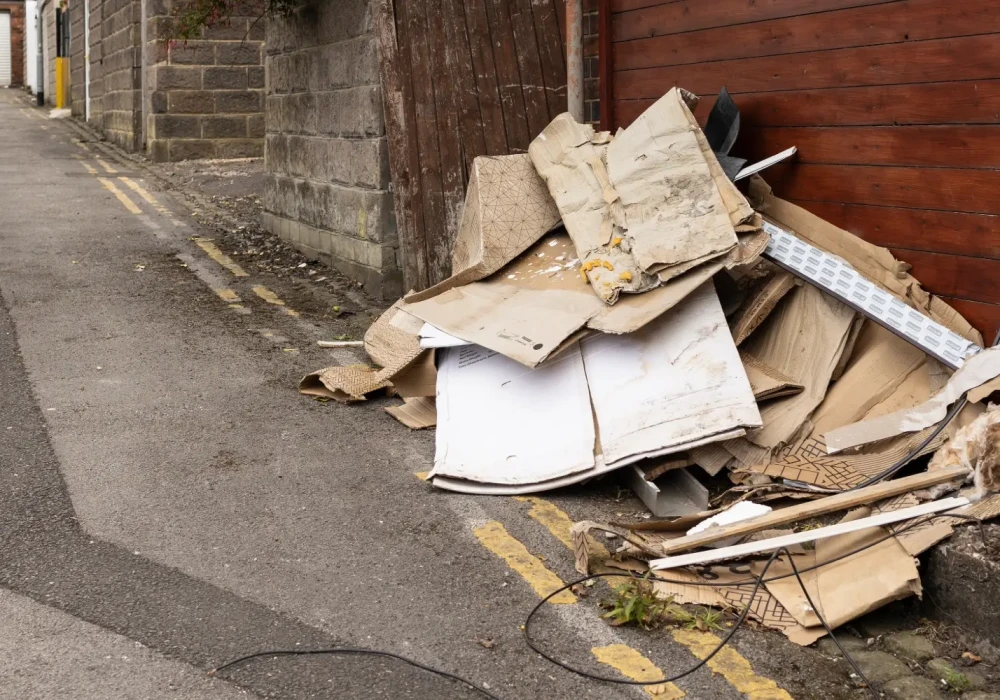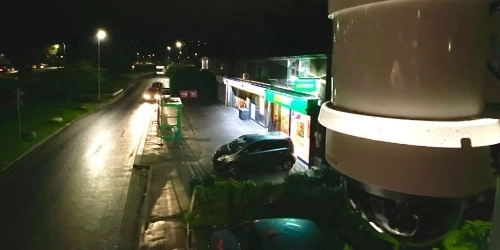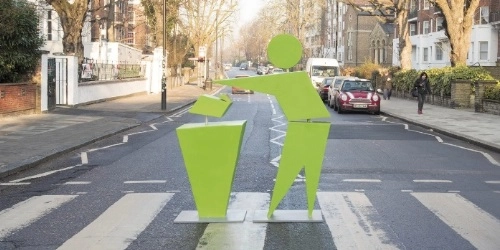Recent data showed fly-tipping continues to hit record highs year-on-year, but what towns and regions face the highest number of incidents? Find out here.
Since the coronavirus, the number of fly-tipping incidents has continued to rise meaning Local Authorities remain on the lookout for offenders in order to recoup cleanup costs associated with this.
With the cost of living crisis placing financial pressures on members of the public across England, many are resorting to either fly-tipping themselves or using cheap removal companies who dump it illegally without the individual’s knowledge necessarily.
How Many Fly-Tipping Incidents Were There in England Last Year?
From recent data reported by Gov.uk, there were a total of 1.15 million fly-tipping incidents during the year 2023/24. This was a 6% increase from the previous year, demonstrating the overwhelming issue faced by Local Authorities across the nation.
60% of these incidents involved household waste, with a total figure of 688,000 incidents over the year.
Additionally, the statistics revealed the sizes of fly-tipping incidents and the commonalities of each one.
It found that 31% of total incidents were equivalent to a ‘small van load’, closely followed by a ‘car boot or less’ which equated to 28% of the overall figures.
Surprisingly, ‘tipper lorry load’ size incidents totalled around 4% over that year, with the cost of clearance stated as £13.1 million across all Local Authorities in England.
But what towns and regions are worst affected by this?
Worst Regions for Fly-Tipping by Reported Incidents
Below provides a list of all regions in England, ranking the highest to lowest number of fly-tipping incidents:
| London | 444,519 |
| North West | 133,578 |
| South East | 101,694 |
| East Midlands | 95,909 |
| East | 86,987 |
| Yorkshire & The Humber | 85,568 |
| West Midlands | 83,980 |
| North East | 68,269 |
| South West | 51,175 |
| Total | 1,151,679 |
Top 10 Worst Towns for Fly-Tipping by Reported Incidents
Below provides a list of the top 10 worst affected Towns in England, ranking the highest to lowest number of fly-tipping incidents:
| Croydon, London | 35,470 |
| Camden, London | 34,786 |
| Hackney, London | 33,464 |
| Nottingham, East Midlands | 30,511 |
| Lewisham, London | 27,599 |
| Hounslow, London | 27,241 |
| Brent, London | 27,023 |
| Westminster, London | 25,531 |
| Southwark, London | 22,912 |
| Liverpool, North West | 20,003 |
| Total | 284,540 |
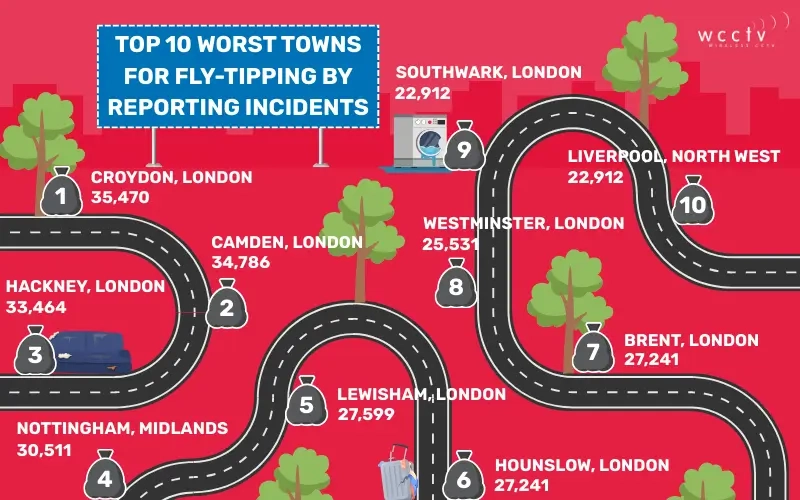
Action Rates by Region vs Incidents
Within the Gov.uk data, it displays not only incident figures, but action rates also.
An action represents the measures taken by Local Authorities to address the issue of illegal waste disposal. This covers various actions including:
- Enforcement action such as FPNs, fines, formal cautions, prosecution, and community service
- Reporting incidents
- Investigations
- Waste clearance
- Duty of care inspections
Below provides a list of all regions in England, ranking the highest to lowest action rates for each one:
| North West | 60.1% vs incidents |
| East Midlands | 56.9% vs incidents |
| Yorkshire & The Humber | 51.2% vs incidents |
| East | 50.8% vs incidents |
| London | 46% vs incidents |
| South East | 36.6% vs incidents |
| North East | 33.9% vs incidents |
| West Midlands | 33.8% vs incidents |
| South West | 24.3% vs incidents |
***Calculation: Total number of actions divided by total number of incidents x 100 = Action rate percentage per region***
Top 10 Local Authorities for FPN Actions
Using the Gov.uk data, we broke down the total number of FPN actions per town to reveal the top 10 Local Authorities regarding their FPN action rate.
This total figure covers the following FPN actions:
- Fixed Penalty Notices issued specifically for fly-tipping
- Fixed Penalty Notices issued for Household Duty of Care
- Littering Fixed Penalty Notices issued in conjunction with fly-tipping
- All Other Fixed Penalty Notices issued
Below provides a list of the top 10 worst affected Towns in England, ranking the highest to lowest number of fly-tipping incidents:
| Islington, London | 149% vs incidents |
| Enfield, London | 76% vs incidents |
| New Forest, South East | 71% vs incidents |
| Wandsworth, London | 56% vs incidents |
| Brighton and Hove, South East | 56% vs incidents |
| Thurrock, East | 55% vs incidents |
| Waltham Forest, London | 51% vs incidents |
| Bexley, London | 44% vs incidents |
| City of London, London | 41% vs incidents |
| Stoke-on-Trent, West Midlands | 37% vs incidents |
***Calculation: Total number of FPN actions divided by total number of incidents x 100 = FPN action rate percentage per town***
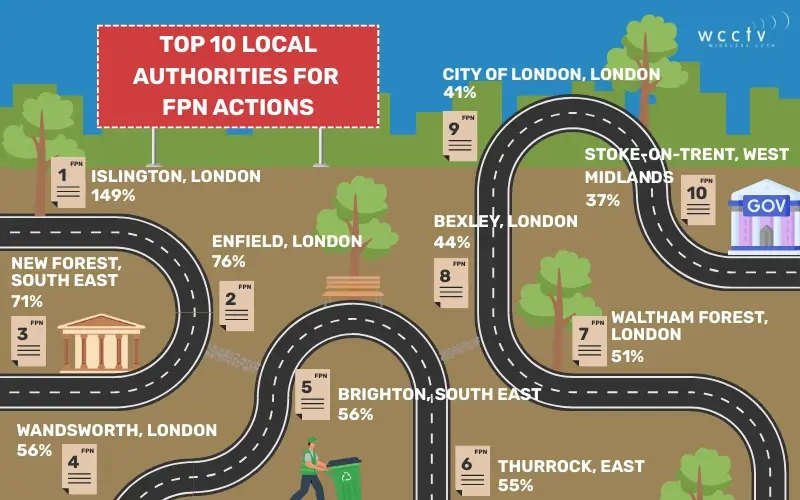
6 Top Tips to Prevent Fly-Tipping
With fly-tipping fast becoming one of the largest issues for Local Authorities across England, we look at 6 ways to prevent this in your area:
Ensure Any Hotspots Are Well-Lit
Most fly-tipping occurs at night, under cover of darkness, so simply installing lighting in key areas can help to deter potential offenders from illegally disposing of waste there.
Lighting helps to provide visibility on that space and removes the concealment provided to offenders with their identity.
Install Security Cameras
Often considered the most effective form of defence against fly-tipping, security cameras can help both monitor and record events for evidential purposes.
Especially with cameras backed by remote monitoring and ANPR services, these systems provide an all-rounded, proactive approach to tackling fly-tipping.
Place Clear Signage Across Town
Nearly a quarter of Britons don’t know fly-tipping is a crime that you can be fined or prosecuted for, meaning that many may not fear the consequences of committing this offence.
Placing clear signage in your local area, particularly at fly-tipping hotspots could have potential offenders second-guessing their actions and deter them from such crime.
Signs can provide warnings, display penalties, and explain how to report fly-tipping crimes, all of which will support your Local Authority in resolving any matters.
Engage With The Local Community
As mentioned, there are many individuals that will be unaware of the consequences of fly-tipping on both the local area and themselves.
Fly-tipping can destroy wildlife and negatively impact the local community, so engaging with them directly can help communicate this impact, promote the reporting of it, and direct them towards the correct channels for waste disposal.
Clear Overgrown Foliage
Fly-tipping most commonly takes place on highways, but also in remote, rural locations where foliage provides cover for them to illegally dispose of any waste.
In both cases, where foliage is overgrown and offering hiding places for such crime, you should clear this as soon as possible and continue to maintain this throughout the year.
Offenders look for opportunities and you need to remain ahead of this.
Create Barriers
There are many ways to create physical barriers to prevent fly-tipping, from placing large logs or natural barriers across a location to placing wiring around hotspots where necessary.
Potential offenders will look to find an easy-access location in order to quickly dump the waste without being caught. Physical barriers have the potential to make this more difficult, and in turn deter them from dumping it there.
Redeployable CCTV Fly-Tipping Use Case
Brighton & Hove Council
Brighton & Hove Council invested in our 4G Mini DomeCameras with ANPR (Automatic Number Plate Recognition) to strategically target fly-tipping hotspots.
They can be rapidly deployed at these locations with them being a wireless solution that operates with complete power autonomy and cellular connectivity.
These high-quality cameras offer advanced IR PTZ capabilities that help to detect, deter and record any fly-tipping activity, whilst the integrated ANPR units capture crystal clear images of vehicle number plates.
Once the fly-tipping challenges in a particular location are resolved, the cameras can be easily relocated to new areas where surveillance is required - allowing the Council to remain agile in their response to crime.
Fly-tipping costs the Council, and therefore residents, more than £100,000 a year, so we’re determined to stop or at least limit that as much as possible.
“These new cameras and further public assistance will help even more in tackling this ongoing problem.” - Councillor Amy Heley
Dealing with fly-tipping in your area? Time to take action and get in touch with the experts below.
